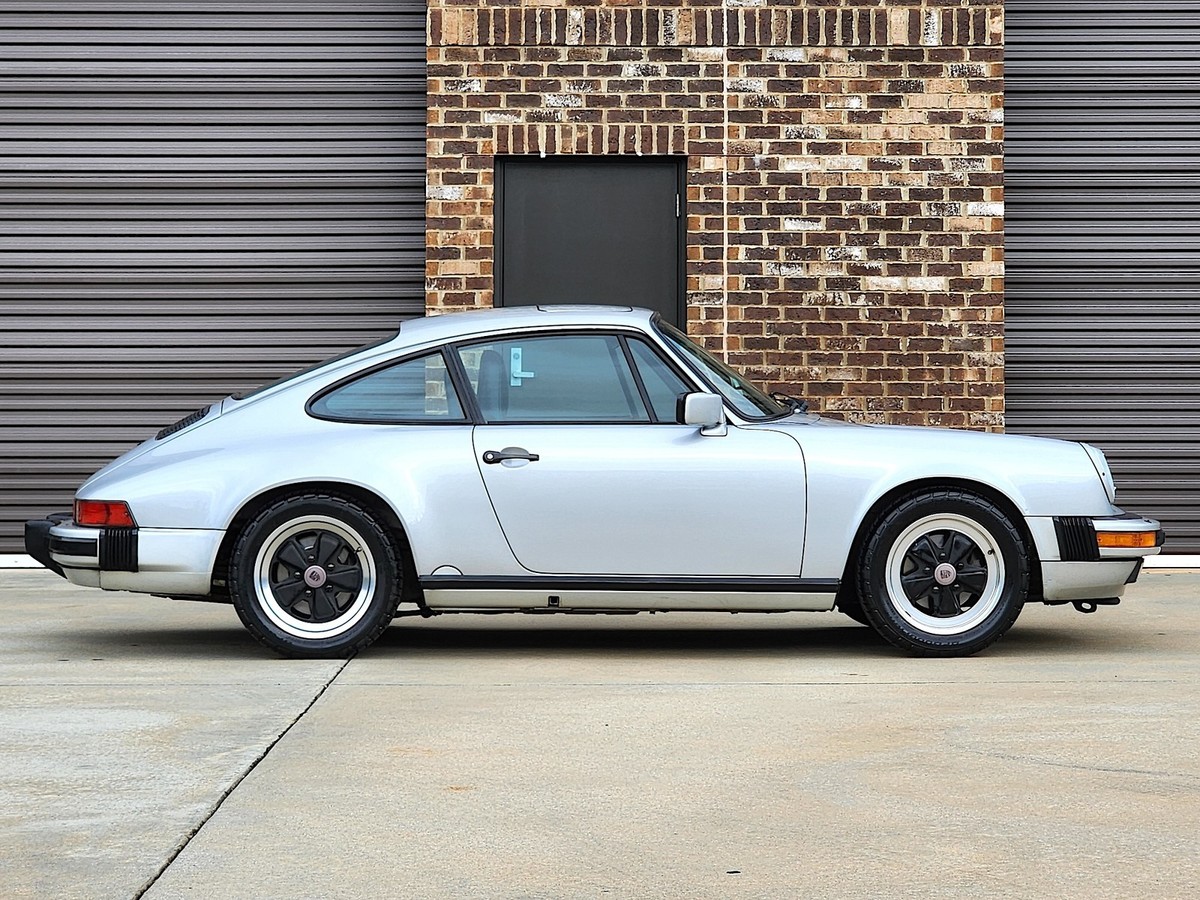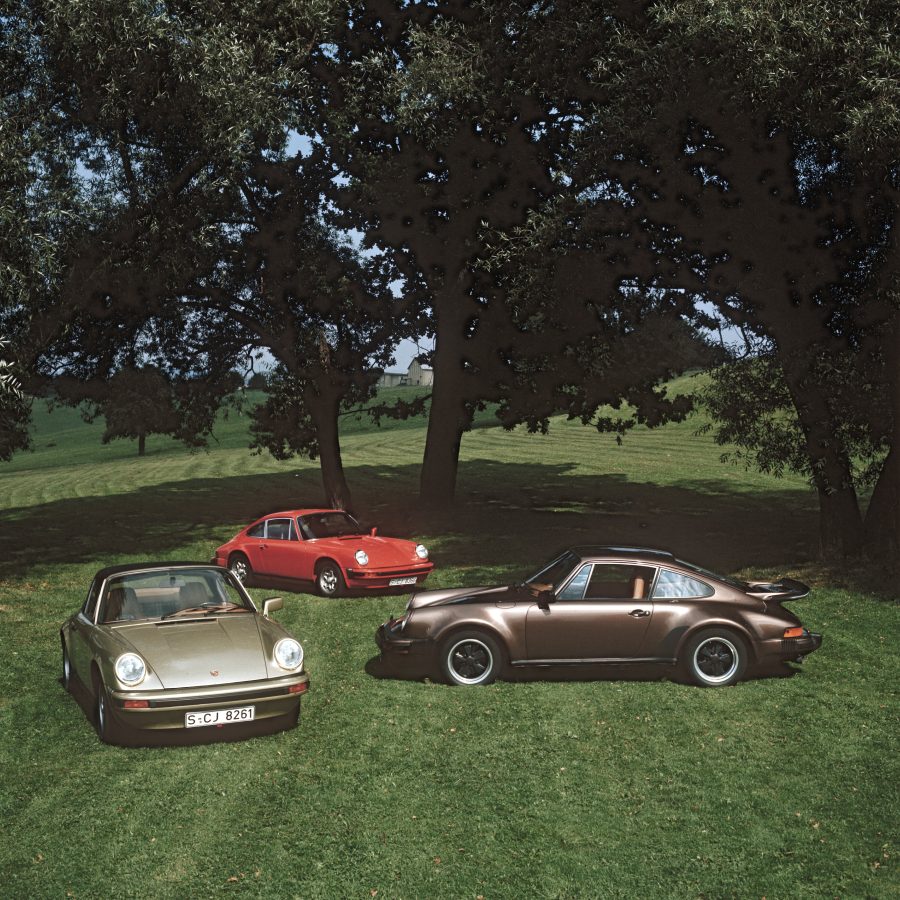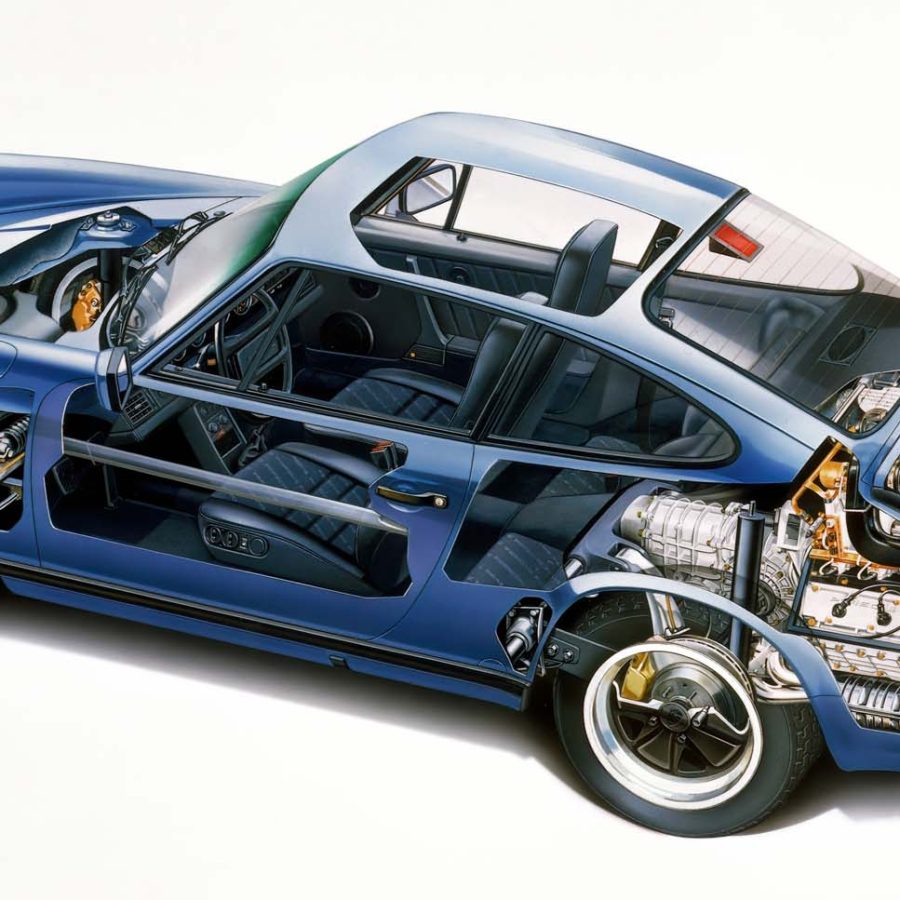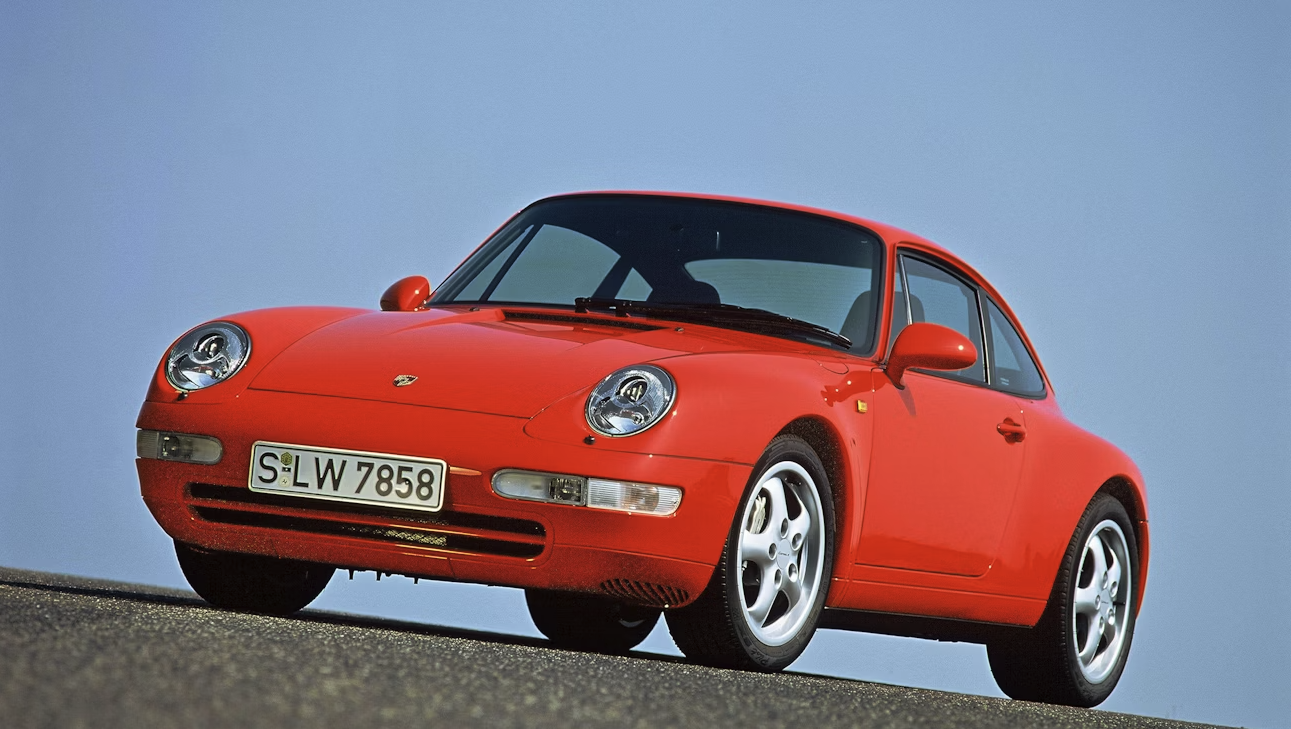Porsche 911 (G-Series) Buyer's Guide
Buying a 1974 - 1989 Second Gen Porsche 911? Our (Seriously In-Depth) Buyer’s Guide Covers Key Variants, Potential Issues, Market Values, Expert Tips, What To Expect & MUCH More.
The Porsche 911 G-Series, produced from 1974 through 1989, represents the second major chapter in the iconic 911 lineage—and arguably one of the most robust, character-rich, and usable classic Porsche eras. Spanning over 15 years of production, the G-Series brought significant safety improvements, refined mechanical components, and growing driver comfort without sacrificing the essential 911 DNA: a rear-mounted air-cooled flat-six, timeless styling, and unfiltered driver engagement. Today, it’s one of the best ways to get into classic 911 ownership—offering both accessibility and long-term collector appeal.
What makes the G-Series 911 especially attractive to buyers is its remarkable range of models and personalities. From the early narrow-body 2.7-liter cars to the muscular 3.2-liter Carrera 3.2s, the widebody Turbo (930), the lightweight 911 SC, and the legendary final-year 1989-only Carrera 3.2 with the G50 transmission, the lineup is varied enough to suit purists, collectors, and drivers alike. Each sub-generation brought improvements to performance, reliability, and refinement—making it critical for buyers to understand the nuances and evolution across the model years. For many, the Carrera 3.2 represents the sweet spot between vintage feel and daily-drivable reliability, while the 911 SC continues to be celebrated for its bulletproof nature and charming analog purity.
In this guide, we’ll explore everything you need to know when shopping for a G-Series Porsche 911—from key variants and model year differences to common issues, market values, investment potential, and expert buying tips. Whether you're after a sunny-day Targa, a spirited coupe, or a turbocharged icon, the G-Series lineup offers a broad spectrum of ownership experiences. And with values on the rise and parts support still excellent, there’s never been a better time to learn why this generation might just be the best-kept secret in classic Porsche ownership.

Why the 2nd Generation Porsche 911 (1974 - 1989) is a Unique Classic to Buy
The G-Series Porsche 911, produced from 1974 to 1989, is a cornerstone of air-cooled 911 heritage. It represents the longest-running generation in 911 history, bridging the early simplicity of the original F-body 911 with more modern usability and safety features. What makes it truly unique is how it balances the raw, analog experience that enthusiasts crave with incremental mechanical and design updates that improved reliability, comfort, and drivability over time. For many collectors and drivers alike, it hits the sweet spot—authentic in feel, but approachable to own and enjoy today.
One of the most defining characteristics of the G-Series is its breadth of variants. From the early 2.7-liter cars to the robust 3.0-liter 911 SC and finally the well-rounded and increasingly desirable 3.2 Carrera, each model brought its own flavor to the classic 911 formula. There’s also the legendary 911 Turbo (930), a game-changing performance icon that remains one of the most exhilarating and collectible variants of any generation. The Targa, with its open-air feel and signature roll hoop, and the Cabriolet, introduced in the early 1980s, offered further versatility to suit every kind of buyer.
Another reason the G-Series stands out is its longevity and the sheer volume of cars produced—especially in later years. This means buyers have a better chance of finding solid, well-maintained examples compared to scarcer earlier generations, and the aftermarket and OEM parts support remains excellent. At the same time, rising values and growing recognition from the collector market make them increasingly smart investments, especially when it comes to the SC and Carrera 3.2. These cars have aged gracefully, and their simplicity relative to newer 911s appeals to purists and hands-on owners alike.
Ultimately, the G-Series Porsche 911 offers a rare blend of classic charisma, mechanical durability, and real-world usability. It’s a classic that can still be driven with confidence, whether on a backroad or to a weekend cars-and-coffee. For enthusiasts who want the soul of a vintage 911 without the sometimes-intimidating fragility or scarcity of earlier cars, the G-Series presents a compelling case—timeless, visceral, and still attainable.
Porsche 911 (G-Series) Models & Variants - A Quick Primer for Potential Buyers On The 2nd Gen 911 Variants & Specials To Think About.
We already have ultimate guide to the second generation Porsche 911 so we don't want to repeat everything here. Instead, we will give you a quick primer and summary about the main F-Series 911 variants, some of the core model year changes and we will talk about some special editions worth noting as you think about your potential purchase.
Key Variants & Differences
Here’s are key variants and differences of the second-generation Porsche 911 (G-Series), produced from 1974 to 1989. This was a pivotal era for Porsche, spanning 15 model years and introducing several important upgrades and sub-models that would influence the 911 legacy for decades.
1974–1977: The Impact Bumper Era Begins (2.7L Models)
With the 1974 model year, Porsche introduced the G-Series 911 to meet U.S. safety regulations. This meant larger, impact-absorbing bumpers front and rear—now a hallmark visual trait of the generation.
Early models carried over the 2.7-liter flat-six from the end of the F-Series, but these engines, especially in the U.S.-spec 911 and 911S, suffered from thermal reactor emissions equipment, often leading to heat-related failures and head stud issues.
Euro-spec cars (like the Carrera 2.7) fared better with more power and better longevity.
Notable variant:
911 Carrera 2.7 MFI (1974–1975): The spiritual successor to the 2.7 RS. Sold in Europe with mechanical fuel injection (MFI) and up to 210 hp. These are among the most collectible G-Body models today due to rarity and performance.
1978–1983: The 911 SC (Super Carrera)
The 911 SC introduced a much-needed return to reliability and consistency.
The displacement grew to 3.0 liters, and Porsche simplified the model line—only one engine option was offered, available in Coupe, Targa, and later (from 1983) Cabriolet body styles. Power output started at 180 hp and increased to 204 hp by 1981 in Euro-spec (U.S. cars had slightly less). The SC is considered by many to be one of the most usable and reliable classic 911s, thanks to improved build quality, a stronger engine with an aluminum case, and better rustproofing.
Buyers should note:
1980–1983 models are generally more desirable due to updated electronics, improved power, and availability of the Cabriolet.
SC models make great entry points for enthusiasts looking for a classic air-cooled 911 without the sky-high prices of earlier or turbocharged models.
1984–1989: The 911 Carrera 3.2
Perhaps the most well-rounded and popular G-Series variant is the Carrera 3.2, which brought the most refinement to the platform without losing the air-cooled character.
The 3.2-liter flat-six offered 207 hp (U.S.) to 231 hp (RoW), giving it solid performance that still feels sprightly today.
Significant changes included:
1987–1989 models received the improved Getrag G50 transmission, which offered smoother shifts and a hydraulic clutch—these models command a premium today.
Updates to the DME system (Digital Motor Electronics), better brakes, and more creature comforts made these models excellent drivers and long-distance tourers.
The 3.2 also came in Coupe, Targa, and Cabriolet versions, and special editions like the Commemorative Edition (1988) and Anniversary Edition (1989) have collector appeal.
The 911 Turbo (930) – 1975–1989
A category of its own, the 911 Turbo (internal code 930) was Porsche’s performance flagship. Introduced in 1975, the 930 had a 3.0L turbocharged engine producing 260 hp.
In 1978, displacement increased to 3.3L with intercooling, bumping power to 300 hp (Euro) and 282 hp (U.S.). These cars were brutally fast for their time and gained a reputation for challenging handling at the limit due to turbo lag and a rear-weight bias. The 930 was discontinued in the U.S. after 1979 due to emissions but returned in 1986–1989, only with a 4-speed transmission.
Today, these later cars, especially with the factory slant-nose (Flachbau) option, are highly collectible and can command six figures depending on condition and provenance.
Special Editions and Rarities
Slantnose (Flachbau): Available from the factory (option code M505), it featured 935-inspired styling with pop-up headlights and wider fenders.
911 Speedster (1989 only): A lightweight, limited-run model based on the Carrera 3.2, with a lower windscreen and tonneau cover. Only about 2,100 were made, and they’re prized by collectors.
M491 "Turbo-Look" cars: Optioned with wide-body fenders, suspension, and brakes from the 930 Turbo, but without the turbo engine. These Carrera 3.2 variants are desirable for offering turbo styling with NA drivability.
Advice for Buyers
Buyers should first decide what they want from the car: an entry-level classic driver, a high-performance collectible, or a long-term investment. The 911 SC and Carrera 3.2 remain the sweet spots for daily usability and reliability, with the 3.2 G50 cars (1987–1989) sitting atop the non-turbo desirability list.
The 930 Turbo, while thrilling, is more expensive to maintain and demands greater respect when driven hard. Meanwhile, rare Euro-only variants like the Carrera 2.7 MFI or Speedster are now in the collector realm, with values to match. Condition, documentation, and originality are critical to resale value—especially for the more collectible variants. Look for cars with full service history, no rust, and no major accident history.
Modified examples can be fun, but factory-spec cars with matching numbers are almost always worth more in the long run.
Model Year Changes (1974-1989)
Here's a year-by-year breakdown of the Porsche 911 G-Series (1974–1989) model changes.
1974
Start of the G-Series generation with new impact bumpers to comply with U.S. crash safety standards.
Engines: 911 (2.7L, 150 hp), 911S (2.7L, 175 hp), and Carrera 2.7 (210 hp in Europe using mechanical fuel injection)
First year of the wider bodywork and revised bumpers; torsion bar suspension carried over from the F-Series.
U.S. cars received Bosch CIS (K-Jetronic) injection; European Carreras kept MFI.
First year of shorter hood and larger bumper bellows.
1975
Minor cosmetic tweaks.
U.S. Carrera adopts CIS injection, losing performance (to around 165 hp) compared to Euro-spec cars.
Introduction of thermal reactors on U.S. cars, which led to higher engine bay temps and reliability issues.
Galvanized floorpan introduced partway through the model year (full galvanization came later).
Early signs of head stud and valve guide wear emerge.
1976
All 911s received fully galvanized bodies, significantly improving rust resistance (a key buyer consideration).
911 trim removed; base model becomes just 911S (165 hp) and Carrera 3.0 (Euro-only, 200 hp).
Simplified engine offerings and emissions equipment in U.S
1977
Final year of the 2.7-liter engine in 911S and U.S. Carreras.
Continued head stud issues and reliability concerns make this the end of the line for the problematic 2.7 engine.
Carrera 3.0 (non-Turbo) ends after this year in Europe—rare and desirable for lightweight chassis and bigger engine.
1978
Debut of the 911 SC (Super Carrera). The entire lineup consolidated into this single model.
All-new 3.0L flat-six (180 hp U.S & 188 hp RoW).
Stronger aluminum engine case, solving many 2.7 issues.
More equipment, wider body look similar to Carrera 3.0.
Retains the 915 5-speed transmission.
1979
Minor refinements and durability improvements.
Same power figures, but improved reliability and quality.
Continued use of Bosch CIS.
U.S. emissions slightly lower hp than Euro models.
1980
Introduction of the Lambda system for U.S. cars
Euro SC models get 204 hp, while U.S. cars still lag at 180 hp.
Known for smoother drivability and further reliability
1981
Largely unchanged, with more options added including limited-slip differential, sport seats.
Improved sound deadening and comfort options.
Continued SC refinement makes this a strong model year.
1982
Power still at 180 hp in the U.S.
Minor updates including interior tweaks and improved A/C
Dealer-installed features become more popular
1983
Final year of the 911 SC.
First and only year of the SC Cabriolet
U.S. power still at 180 hp; RoW remained at 204 hp.
SC reliability and simplicity make it a strong value buy.
1984
Introduction of the 911 Carrera 3.2, replacing the SC.
New 3.2L with Bosch injection: 207 hp (U.S.), 231 hp (RoW).
Still used the 915 gearbox, but with further refinements.
More modern electronics, better drivability, and new dashboard features.
1985
Minor cosmetic tweaks and improved heating system
Suspension and brake refinements for better handling
Introduction of Central Warning Light System for faults.
1986
Carrera Cab and Targa continued; coupe remains most rigid.
Tweaks to Motronic tuning and optional comfort features.
Porsche reintroduces the 930 Turbo to the U.S. market after a six-year absence.
1987
Introduction of the G50 transmission—a major mechanical upgrade with hydraulic clutch and better shift feel.
Slight increase in curb weight due to the new gearbox.
First year that 3.2 Carrera is fully “modernized” in feel.
1988
Largely carried over mechanically.
Multiple special editions released:
Commemorative Edition (for Ferry Porsche's 75th birthday).
Optional M491 “Turbo-look” package more common.
1989
Final year of the G-Series.
Introduction of the limited-production 911 Speedster: 2-seater, chopped windshield, unique clamshell tonneau.
Continued use of G50 gearbox.
End of the classic narrow-body 911 before the 964 took over.
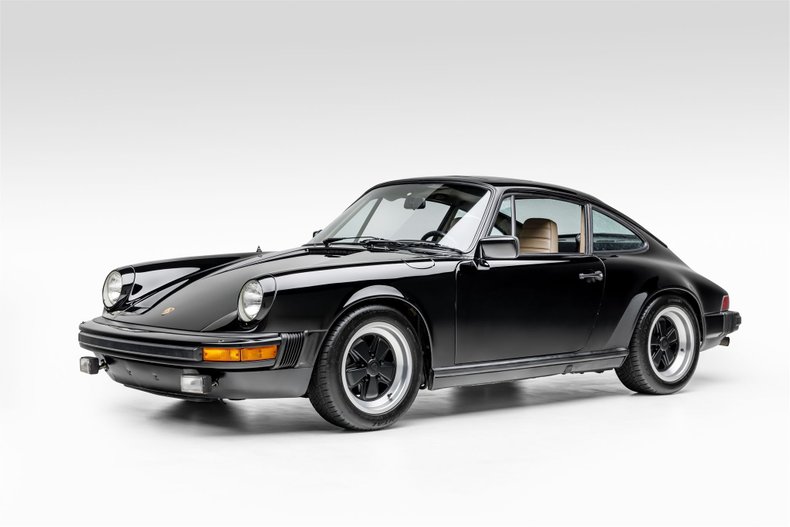
2nd Generation Porsche 911 Market Value & Pricing
When buying a G-Series Porsche 911, understanding market values and what drives pricing differences is crucial. Here’s a concise summary of market values and pricing for the second‑generation Porsche 911 G‑Series (1974–1989), based on recent data and market commentary.
Used G‑Series 911s today trade broadly from US $50,000 to $120,000+ for the more common models in fair‑to‑good condition. For example, one market source notes that “entry‑level examples and project cars can dip below that range, while top‑spec models and collector‑grade examples easily reach six figures.” Listings and aggregate data show an average sale price around US $101,000 for G‑Body 911s across all conditions and variants.
That said, significant value differences exist based on variant, condition, originality, and specification. Rare trims like the early Carrera 2.7, 930 Turbo models, limited‑edition Speedsters, and late‑model G50‑gearbox Carreras command premiums well into the hundreds of thousands of dollars. At the same time, more common SC or 3.2‑litre models in higher mileage or less desirable condition can be found for significantly less—sometimes in the US $40,000–$60,000 range depending on geography and spec. With rising interest in air‑cooled Porsches and restricted supply of high‑quality examples, many observers believe the G‑Series market is poised for continued strength.
What Are G-Series Porsche 911s Worth?
The price of a Porsche 911 from the second generation G-Series varies widely based on condition, originality, model variant, and desirability. Below is a breakdown of pricing into five categories—ranging from restoration projects to concours-level examples—along with insight into what buyers can expect in each bracket.
Project Cars/Non-Runners
$30,000 - $60,000
These are vehicles that require significant mechanical and cosmetic attention. These often include rust issues, tired interiors, tired engines, non-running drivetrains, accident damage, or cars that have been partially disassembled. Docs are usually thin and originality may be compromised. This tier is typically attractive to hands-on enthusiasts or restoration specialists who are prepared for a lengthy and often expensive rebuild process. They're cheap, but total investment to reach a good standard can easily surpass buying a better car upfront.
Driver-Quality Examples
$60,000 - $90,000
This bracket represents honest, usable 911s that can be driven and enjoyed, but which show their age. These cars usually run well, but may have deferred maintenance, cosmetic wear, tired suspension components, or aging interiors. They might have higher mileage, less desirable colours, or minor modifications. For buyers wanting a vintage 911 experience without perfection anxiety, this can be a sweet spot — but budgeting for ongoing mechanical refreshes is essential. These are the cars that form the backbone of the G-Series market.
Quality, Well-Maintained Originals
$90,000 - $150,000
This is where you begin to find truly desirable G-Body 911s. These cars are well cared for, often matching numbers, with solid service histories, minimal corrosion, and strong mechanical health. They may have undergone tasteful restoration or preservation work and are suitable for both spirited driving and light concours presentation. Most buyer-focused sweet-spot cars fall into this range, especially good Carrera 3.2 and high-quality 911 SC models. These cars balance usability, collectibility, and value confidence.
Collector-Grade & Rare Variants
$150,000 - $300,000
This tier includes excellent condition cars with low mileage, rare colours, highly desirable specs, or pristine originality. Think late-model G50 Carrera 3.2s, rare early 2.7 Carreras, factory M491 Turbo-look cars, or highly preserved examples with full documentation and provenance. These vehicles often sit in climate-controlled garages, appear at concours events, and are treated as true collectible assets. Market appreciation and long-term value stability play a larger role for buyers here.
Top-Tier & Blue-Chip Collectibles
$300,000 - $500,000+
At the top of the market are investment-grade icons such as Porsche 930 Turbos, 1989 Speedsters, rare Euro-only performance models, slantnose factory conversions, and museum-quality cars with impeccable histories. These examples represent the pinnacle of desirability and are often bought as long-term assets rather than purely for driving enjoyment. Prices here are heavily influenced by rarity, originality, provenance, and collector demand, and exceptional examples can climb even higher.
Factors That Affect Value
When it comes to the factors that affect the value of second-generation Porsche 911s (G-Series, 1974–1989), the market is shaped by a unique combination of originality, specification, provenance, and market sentiment. These are cars that span a critical evolution of the 911—from impact bumper innovation to galvanized steel and increasing refinement—so not all G-Body 911s are viewed equally in the eyes of collectors and drivers alike.
1. Model Year and Variant
Not all G-Series cars carry the same cachet. Early impact-bumper models (1974–1977) are generally less valuable than the later SC (1978–1983) and especially the Carrera 3.2 (1984–1989). The 3.2-liter Carrera is considered by many to be the sweet spot for usability, power, and reliability. Within the 3.2 line, 1987–1989 models with the upgraded G50 transmission are the most desirable. Targa and Cabriolet versions are typically valued lower than Coupes, though clean, rust-free examples with great provenance will always stand out.
2. Condition and Originality
As with all classic cars, condition is paramount. Rust is the G-Body’s greatest enemy, especially for earlier, pre-1977 non-galvanized models. Cars that retain their factory colors, matching numbers, and original interiors will command premiums. Modifications—especially those that aren’t period-correct or reversible—can reduce value unless they are well-documented performance or preservation upgrades (e.g., SSI exhausts, upgraded A/C, or tasteful suspension tweaks). A well-preserved, high-mileage original car may be more valuable than a cosmetically restored but poorly maintained example.
3. Provenance and Documentation
A strong service history and traceable ownership chain play a major role in value. Full documentation—including stamped service books, original manuals, window sticker, and service receipts—enhances confidence and credibility. Cars with known history, especially those with fewer owners or long-term single ownership, tend to be more desirable. Special edition models (like the 911 Turbo 3.3, M491 “Turbo-look” cars, or limited-run editions like the Commemorative or Anniversary models) also carry a premium, particularly if documented properly.
4. Color, Options, and Rarity
Color combinations matter more than you might think. Unusual or period-popular hues—like Minerva Blue, Oak Green Metallic, or Cassis Red—can increase appeal if they match the car’s character and are original to the car. Factory options like sport seats, sunroofs, A/C, and limited-slip differentials (especially on the Carrera) are desirable. Rare option codes (like M491 wide-body “Turbo-look”) or special-order “paint to sample” cars can significantly bump value if documented.
5. Current Market Trends and Sentiment
Finally, macro trends in the collector market play a role. Air-cooled 911s, especially G-Series cars, saw a meteoric rise in value from the early 2010s through 2016. While values cooled slightly, they have remained strong thanks to the 911’s bulletproof reputation and enduring enthusiast appeal.
As interest in analog, driver-focused cars remains high, well-kept G-Body 911s—especially Coupes, Carreras, and G50-equipped models—are viewed as both usable classics and long-term collectibles.
Investment Potential
When considering the investment potential of the G‑Series (1974 – 1989), there are compelling reasons to believe this era offers strong value, especially for the right models. At the same time, as with all “car investments,” it comes with caveats and needs careful selection rather than assuming a guaranteed profit. Here’s an expert view of the landscape, along with some specific models worth calling out.
First, why the G‑Series is appealing from an investment standpoint: This generation spans a long production period, yet includes models with meaningful evolution (engine size ups, gearbox refinements, and performance variants). According to valuation guides, the Carrera 3.2 models consistently sit above many earlier SCs in value, reflecting their usability, refinement, and “last of that era” status.
Because the air‑cooled 911 market has already seen strong demand, late‑impact‑bumper G‑Series cars (especially well‑prepared, low‑mileage examples) are viewed by many as undervalued relative to early long‑hood 911s — meaning there is “room to grow”.
In short: buy the right G‑Series, and you may benefit from both driver enjoyment and potential value appreciation.
That said, the investment upside is model‑dependent. For example, the 911 SC (1978‑1983) is celebrated for its bullet‑proof engine and approachable collectibility. A well‑maintained SC that ticks the boxes (stellar service records, low rust, desirable option spec) could serve as the “value entry” into investment territory. Then there’s the Carrera 3.2 (1984‑1989) — especially the 1987‑1989 cars that come with the upgraded G50 gearbox — which are increasingly considered the sweet‐spot for owning a collectible yet usable 911. Finally, elite models like the 911 Turbo (930, 1975‑89) and factory rare variants (e.g., Speedster, M491 Turbo‑look) remain the top tier for investment, though they demand premium pricing and careful budgeting for ownership.
However, many experts caution that cars are seldom “investment vehicles” in the traditional sense. One well‑quoted forum post noted:
“Long story short, you’re not going to make any money on any 911 in that price range… once you factor maintenance and insurance, you’ll be in the red.” Reddit
This underscores that the financial return alone shouldn’t drive the purchase; the primary reward is the driving experience, heritage, and ownership satisfaction — with any appreciation viewed as a bonus.
Key Models to Keep on Your Radar
911 SC (1978‑1983): Widely regarded for its combination of reliability, refinement and collectibility.
Carrera 3.2 (1984‑1989): Especially 1987‑89 with G50 gearbox — strong driver appeal + growing collector status.
911 Turbo (930, especially 3.3L later years): The performance icon of the generation; high barrier to entry but strong upside.
Limited Production / Rare Spec Cars: Speedsters, M491 “Turbo‑look”, unusual factory colours/options — these often trade on rarity and story.
Recent 2nd Generation Porsche 911 (1974-1989) Values & Market Sales Trends
Below, our friends at Classic.com chart recent sales and trends in the second gen Porsche 911 market. We've included just the broad G-Series market in general, the Carrera 3.2 and also the 930 Turbo. If you want to go variant by variant, check out the full website at Classic.com and you can choose any variant you want.
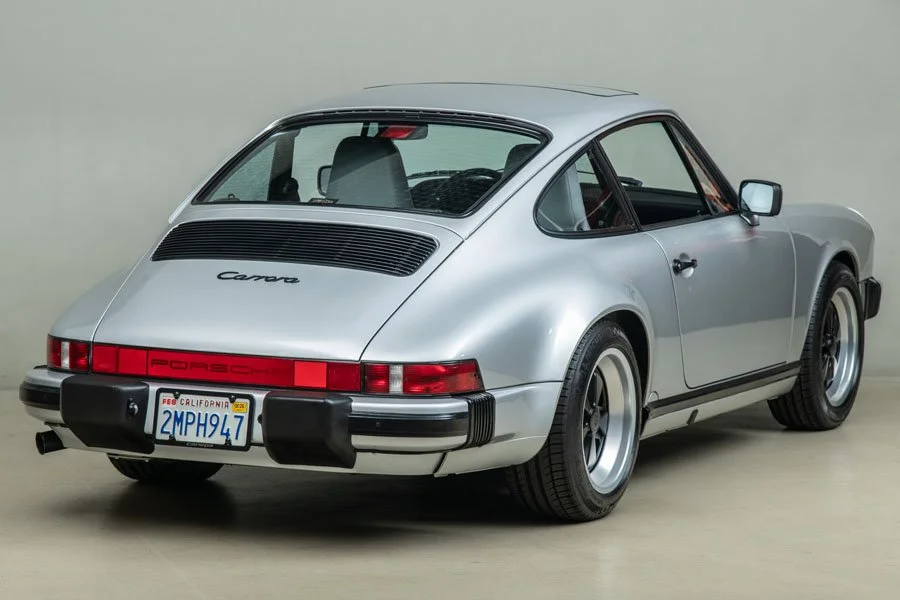
1974 - 1989 Porsche 911 (2nd Gen) Driving Experience & What to Expect
The second-generation Porsche 911 (G-Series, 1974–1989) offers a driving experience that is deeply analog, rewarding, and character-rich — something that modern sports cars, no matter how capable, often can’t replicate. While these cars evolved significantly over their 15-year production run, they retained the quintessential 911 formula: rear-engine layout, air-cooled flat-six engines, and an engaging, communicative driving dynamic that has become the hallmark of the brand. For the enthusiast seeking mechanical purity and visceral feedback, this generation delivers a distinctly old-school flavor with genuine pedigree.
Handling & Performance Expectations
The G-Series 911s are nimble, lightweight by today’s standards, and provide excellent feedback through the unassisted steering. Earlier cars, such as the 1974–1977 2.7-liter models, feel particularly light and tossable, though they lack some of the refinements and reliability of later variants. The 911 SC (1978–1983) brought more robust torque and a stronger 3.0-liter engine, while the Carrera 3.2 (1984–1989) offered the best balance of performance and usability, with up to 231 hp in later models and more consistent power delivery thanks to the Bosch Motronic system.
Driving a G-Series car fast takes finesse. There’s ample grip, but the rear-engine weight bias rewards smoothness and punishes mid-corner throttle lifts — something often referred to as the “911 learning curve.” That said, once mastered, the chassis rewards with a sense of agility and intimacy that’s hard to find in more modern machines. Braking performance is good for its era, but you’ll need to recalibrate your expectations if you’re coming from a modern sports car with big carbon ceramics and ABS.
Daily Use vs Weekend Cruiser
While these cars were once daily drivers, the reality today is that most owners use them for spirited weekend drives, classic rallies, or local events. That said, with proper maintenance, a G-Series 911 can still be surprisingly usable. The cabin is simple and ergonomic, with excellent visibility and a reasonably comfortable ride — especially in non-Turbo variants. The earlier 915 gearbox requires a deliberate hand and rewards mechanical sympathy, while the later G50-equipped Carreras (1987–1989) offer a much more refined shifting experience that’s better suited for modern expectations.
If you live in a mild climate and have tolerance for the occasional classic-car quirk, the 911 SC or Carrera 3.2 can absolutely function as a part-time daily or a reliable weekend machine. Many owners also find joy in the mechanical simplicity: no drive modes, no screens, just you and the machine.
Final Thoughts for Buyers
Modern drivers accustomed to electronic stability control, adaptive suspension, and touchscreen interfaces may initially find the G-Series 911 a bit raw — but that’s precisely the point. These cars are about driving in the purest sense. The flat-six engine’s raspy howl, the mechanical tactility of the controls, and the lively steering create an experience that is rare in today’s sanitized automotive world.
Among all the variants, the Carrera 3.2 with the G50 gearbox is arguably the most well-rounded for buyers looking to use and enjoy their classic 911 regularly, while the 911 Turbo (930) offers unmatched drama and collectible cachet. No matter which you choose, a well-maintained G-Series 911 promises timeless charm, connection, and a driving experience that transcends numbers on a spec sheet.
Getting Real - Costs to Own & Maintenance
Owning and maintaining a Porsche 911 G‑Series (1974‑1989) can be incredibly rewarding—but it’s important to budget realistically for both routine upkeep and the occasional big repair. Here’s a breakdown of what to expect in terms of costs, parts availability, insurance, and ownership considerations:
Maintenance & Ownership Costs
While figures for this generation are less widely published than they are for modern cars, real‑world owner discussions suggest that annual maintenance for a well‑kept G‑Series 911 typically falls in the US $2,000 to $4,000+ per year range if the car is driven regularly and maintained properly. For example, one forum owner noted that oil changes, minor services and tires alone can add up rapidly.
Major services or engine/transmission rebuilds are significantly more expensive. Some owners report engine‑out jobs or major mechanical refreshes costing US $10,000+, especially if the car has been neglected or has internal wear.
Parts availability is strong. Because numerous enthusiast and specialist vendors cater to air‑cooled 911s, many components are still readily obtainable—everything from engine internals to bodywork for impact‑bumper cars. However, labour for specialist work is a big cost driver, and older cars often require more frequent check‑ups.
Insurance, Usage & Budgeting Considerations
Insurance for a G‑Series 911 will vary widely depending on location, how much you drive, your driver history, and whether the car is classified as a “classic” (with mileage limitations). While exact averages for the G‑Series aren’t easily found, one general classic‑car guideline says modest annual premiums may apply, but you should budget for hundreds to a few thousand dollars per year depending on your cover and vehicle value.
Another factor: as these cars age, some components (suspension, seals, wiring) inevitably require replacement simply due to time. If you plan to drive the car often—particularly in varied weather or high mileage—you’ll want to reserve a maintenance contingency. Also, unlike new cars, some “hidden” costs like rust repair, rare parts sourcing, or accident damage can add up quickly. Finally, it helps to view ownership of a G‑Series 911 in two ways: as a usable classic and as a collector asset. The more you use it, the more wear you’ll incur; the more you store it, the more you’ll still face age‑related maintenance. Balancing enjoyment with upkeep is key.
Final Takeaway
If you’re buying a G‑Series 911 with good documentation, solid service history and minimal rust, you can expect manageable running costs in the few‑thousand‑dollar‑per‑year range for moderate use. But anticipate occasional large bills for major mechanical work. The big savings come from buying a well‑sorted example from the start. When that’s done right, you get one of the most character‑rich, engaging drivers in the classic‑911 world—with costs that, while higher than a mundane car, are quite reasonable for the joy and heritage on offer.
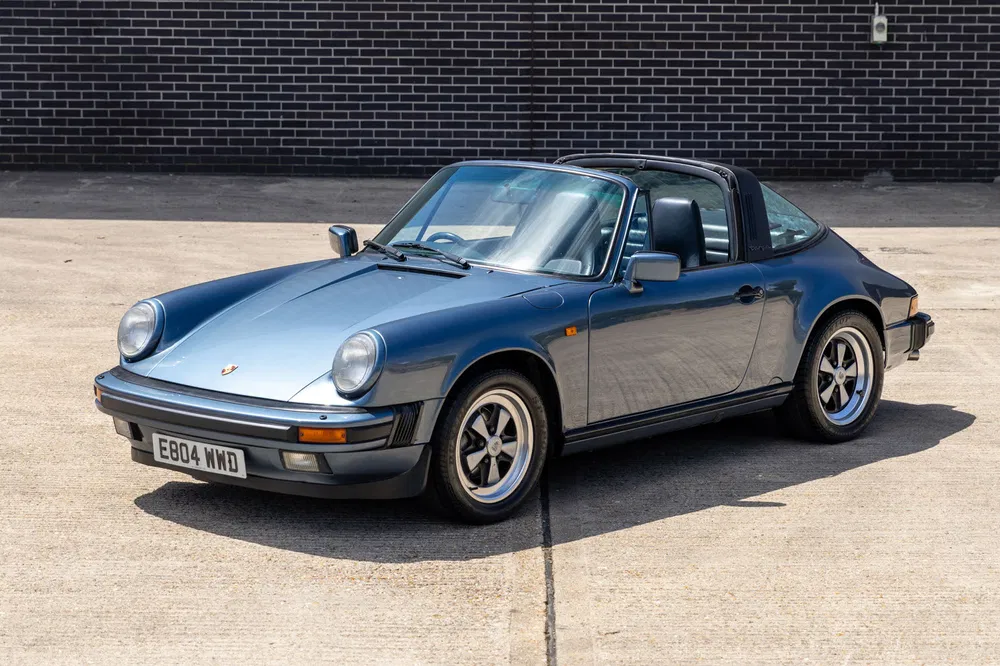
Other Key Buying Considerations
Ensuring Performance, Authenticity, and Long-Term Enjoyment
When buying a second-generation Porsche 911 there are several key considerations beyond the obvious factors like price, condition, and mileage. These 911s are valuable collector items and also engaging driver’s cars—so buyers need to weigh originality, provenance, restoration quality, and intended use carefully. Below are the essential considerations every prospective buyer should think through before taking the plunge:
Rust, Accident History & Structural Integrity
Rust is arguably the number one enemy of any classic 911, especially G-Series cars, which were not fully galvanized until 1976. Early models (1974–75) are particularly vulnerable in the floorpans, torsion bar areas, sills, battery tray, and fender bottoms. Accident damage and improper repairs can also be a dealbreaker—look for signs of crumpling, poor welds, overspray, or non-factory seam sealer. A professional pre-purchase inspection (PPI) is critical, and buyers should always prioritize structural condition over cosmetics or options.
Matching Numbers & Documentation
Matching engine and transmission numbers (as verified against the Kardex or Certificate of Authenticity from Porsche) are very important to collectors and should be confirmed for investment-grade cars. The presence of factory-original parts and finishes—paint, interior materials, gauges, etc.—will also add value. A strong paper trail, including ownership history, service records, and registration data, can provide peace of mind and help support the car’s provenance. For modified examples, documentation of high-quality work is essential.
Originality vs Modifications
While some enthusiasts prefer cars modified for performance or period-style upgrades (such as backdates or outlaw builds), originality remains king in the collector market. That said, tasteful, reversible mods like upgraded torsion bars, improved air conditioning, or period-correct wheels don’t necessarily hurt value—especially if the original parts are included. The most important thing is that any modifications were professionally done and well-documented.
Transmission Type (915 vs G50)
The 915 5-speed gearbox (used until 1986) is less forgiving than the later G50 (introduced in 1987), with a notchy feel and more delicate synchronizers. While many purists appreciate the 915’s period charm, the G50 is generally favored for its improved shift quality and durability. If you’re new to classic Porsches, or plan to daily drive your car, the G50 may offer a more user-friendly experience.
Driving Intent: Show Car, Weekend Toy, or Daily Driver?
Understanding how you want to use the car should shape your purchase. A concours-level or rare model may be best as a lightly driven collector piece, while a mechanically sound but cosmetically imperfect example can make a great weekend driver. If you're looking to drive often, prioritize mechanical health and creature comforts like working heat and A/C. Remember, these are analog cars—there’s no traction control, ABS, or power steering—so choose a car that fits your driving style and confidence level.
Rarity and Desirability of the Model Year or Trim
While most G-Series 911s share a similar basic shape, specific models (like the 911 Carrera 3.2 Clubsport or 911 SC Weissach Edition) are much rarer and can command significant premiums. Even color can affect value—paint-to-sample or period-specific colors like Mexico Blue or Oak Green are highly desirable. Do your homework on production numbers and available options for each model year.
Access to Specialist Support & Community
Finally, one of the joys of classic 911 ownership is the robust enthusiast network. Whether through Porsche Club of America (PCA), Pelican Parts forums, Rennlist, or local air-cooled shops, there is no shortage of advice and support. Before buying, make sure you have access to a qualified mechanic familiar with air-cooled 911s—or be prepared to learn and wrench yourself.

Common 2nd Gen Porsche 911 Problems
What Buyers Should Know
When considering a second‑generation Porsche 911 G‑Series (1974–1989), it’s wise to go in with your eyes open: while these cars are widely regarded as among the best “classic 911” buys thanks to improved usability and reliability, there are common problems that repeat in the marketplace—many of which stem from age, factory tolerances of the era, and variant‑specific quirks. As an expert, I’ll walk you through the biggest red flags, what to look out for, and how they affect buying decisions.
Engine & Powertrain Issues
One of the most documented weak spots across G‑Series 911s is engine‑related wear and emission‑equipment stress—especially in the early 2.7‑litre models. For example, the CIS (Bosch K‑Jetronic) injection system used during the mid‑1970s is known to develop poor mixture, rough idle, and reduced performance if neglected.
Also, head stud pull‑outs (especially in earlier engines running high temps or modified) and valve guide wear show up more frequently than many first‑time vintage buyers expect. For example, a buyer summary warns:
“Check for oil leaks, rattle, and blue smoke. Problematic engines will fail to deliver the power, and if the engine feels slow and does not accelerate properly, it suggests that it has problems with fuel injection.”
Therefore, when you’re inspecting one of these 911s: measure oil pressure, check for blue smoke on cold start, verify CIS or Motronic systems are working correctly, and check for engine‑out history or major rebuilds.
Rust & Body/Chassis Corrosion
Even though Porsche moved to fully galvanised bodies from about 1975 onward, G‑Series 911s still age into rust trouble—especially early models, Targas or Cabriolets which have been exposed to weather. Reports point to trouble zones in the trunk area (battery tray), rear wheel arches, floor pans, torsion bar sub‑frames, and any area where drainage may be clogged (sunroofs, Targa channels).
A buyer guide succinctly states:
“Rust is a big problem when looking for a classic G‑Series model … Only if the car was exceptionally well‑kept, the rust problems could be avoided.”
When buying, inspect underneath the carpet, check sills and battery boxes, look for patched sheet‑metal or overspray, and budget generously for structural repair if corrosion is present.
Gearbox, Driveline & Chassis Wear
Transmission and driveline health are critical. Many G‑Series 911s use the 915 or later G50 gearboxes, and issues like worn synchros (especially in 2nd and 3rd gear), clutch wear, and worn linkage are common. Also, consider that many of these cars have had performance upgrades or track use, which increases wear on drivetrain components. Additionally, suspension bushings, shocks, torsion bars, and steering boxes may be original or tired—leading to vague handling, imprecise steering feel, or a disconnected driving sense. One community thread warns:
“Air‑cooled 911s have a dry sump oil system … if you don’t get the engine up to temperature, you won’t circulate all of your oil.”
This reinforces that usage patterns matter: infrequent starts, short hops, or weather exposure accelerate wear.
Electrical & Accessory Aging
Though not as exotic as modern electronics, G‑Series 911s still suffer from the age‑related problems of any 30‑ to 50‑year‑old car. Outlets, switches, wiring loom insulation, instrument clusters, and ageing modular units can all cause annoying—or expensive—issues. The common problems list for the broader air‑cooled 911 era mentions this explicitly.
When you’re assessing one, check air conditioning (if equipped), interior wiring behind seats/trunk, sunroof mechanisms (for Targas/Cabs), and climate/heater functionality.
Final Thoughts for Buyers
If you’re looking to buy a G‑Series 911, treat the inspection as if you’re buying a serious vintage car — because you are. Verification of major engine service, drivetrain history, body‑chassis integrity, and documented usage will differentiate a good one from a hidden money sink. Many mitigate risk by focusing on the later 3.0/3.2‑litre models (1980‑89) with stronger parts, better systems (Motronic, G50 gearbox), and better parts availability. If you find a pristine, well‑documented example with minimal rust, strong service history, and no major mechanical issues, you’ll have one of the more usable air‑cooled classics out there. Just go in informed — and budget for more than just the purchase price.
Buying A 1974 - 1989 Porsche 911 (2nd Generation) FAQs
Here are all the questions we've received from readers considering a 1974-1989 Porsche 911 for their garage
What to look for when buying a 2nd gen 911 in terms of authenticity & documentation
First, check for factory build verification. You’ll want to obtain or review the official documentation from Porsche itself, such as the Porsche Production Specification (PPS) or the Classic Technical Certificate (CTC). The PPS lists the car’s original build specs—production date, exterior & interior colour, optional equipment, engine and transmission type.
The CTC goes further: it confirms the actual engine and transmission numbers currently in the vehicle match what was recorded at production, and includes an expert inspection of the car’s technical condition. For a genuine collectible, matching numbers and correct option codes matter significantly.
Second, verify the ownership history, service records, and factory‑option details. Track how long each owner held the vehicle, review invoices for major services or engine rebuilds, and check if major modifications were made—especially those that affect originality. Enthusiast‑guides stress that “small details carry outsized weight” when considering provenance, and that you should be able to confirm factory‑specified colour, upholstery, and equipment. In short, a car that comes with a documented consistent chain of care and correct specifications is much more appealing and reliable as an investment than one without such records.
In summary: Don’t just fall in love with the look or drive of a G‑Series 911—confirm its story. Request the PPS or CTC, check matching numbers, examine service history and previous ownership, and verify factory‑options. These documentation checks help you differentiate between a car that looks right and a car that is right, from both a driving and value standpoint.
Just how important are service records and ownership history?
Service records and ownership history are absolutely vital when buying a vintage Porsche 911 (especially a second-generation G-Series from 1974–1989), and they can significantly impact both the car’s value and your ownership experience. Here’s why they matter so much:
Service Records: Peace of Mind & Proof of Care
For a car that could be 35–50 years old, having detailed maintenance records is critical. A well-documented service history confirms that vital components—like the engine, gearbox, suspension, brakes, and electrical systems—have been properly maintained or rebuilt. This matters even more with air-cooled 911s, where deferred maintenance can lead to very costly repairs.
For example, an engine rebuild on a 3.2-liter Carrera could cost $15,000–$25,000 depending on scope. Knowing that such work was completed by a reputable specialist, and seeing supporting invoices, gives you a clear picture of the car’s health. Missing or vague records introduce risk—and buyers pay less when documentation is absent.
Ownership History: Provenance & Confidence
The number of prior owners and the nature of their ownership also affect a car’s desirability. A long-term owner who kept the car in a climate-controlled garage and serviced it at a Porsche specialist is a much better sign than a string of unknown or neglectful owners. Clean, traceable ownership history (ideally with a Porsche Certificate of Authenticity or a PPS/CTC from Porsche Classic) reassures buyers that the car hasn’t been abused, raced, or poorly modified.
Furthermore, with collectible variants (like an early Carrera 3.0 or a limited-edition Anniversary model), ownership history can add value. A known provenance or a car from a respected collection makes a big difference when it comes time to sell.
Value, Insurance & Marketability
Buyers and insurers alike are willing to pay more for well-documented cars. From a resale perspective, a car with decades of paperwork will always attract more serious buyers—and command a premium over a car with spotty or missing documentation. In today’s market, it’s not just about condition—it’s about confidence. And service records plus a clean ownership trail are the foundation of that confidence.
Originality vs. Modified 2nd Gen 911s: What’s More Valuable?
When it comes to second-generation Porsche 911s, originality vs. modification is a central debate among buyers and collectors—and the right answer depends heavily on intent. Whether you’re buying as an investor, enthusiast, or weekend driver shapes what’s most valuable to you.
Originality: The Gold Standard for Collectors
In most cases, originality commands the highest market value, especially for rare or limited-production variants like the 911 Carrera 3.0, 911 SC Weissach Edition, or early 930 Turbos. Original paint, factory-spec interiors, matching-numbers engines and transmissions, and period-correct accessories (Fuchs wheels, Blaupunkt radios, etc.) all add to the car's provenance and desirability. Cars with factory options documented by a Porsche Certificate of Authenticity (CoA) or Kardex are even more prized.
For buyers looking at long-term appreciation or concours-level presentation, a well-preserved, unmolested G-body 911 is the ideal target. This segment of the market values "time capsule" cars and will pay a premium for them.
Modifications: Purpose-Built Enjoyment and Performance
On the other hand, tastefully modified G-body 911s can offer superior driving experiences at more accessible prices, especially if you're less concerned about originality and more focused on real-world enjoyment. Updates to suspension (Bilstein shocks, turbo tie rods), brakes, or even engine swaps (such as a 3.6L from a 964) can transform a 911 into a razor-sharp canyon carver. Hot rod builds, outlaw-style customs, and backdated conversions inspired by Singer or Emory can appeal to a specific niche of buyers.
However, the resale market for modified cars is narrower and more subjective. Value depends greatly on the quality and reputation of the modifications. A car built by a renowned shop with well-documented work may retain good value, but a "homebrew" project with undocumented changes will almost always sell at a discount.
Buyers: Know What You Want
If you’re shopping for a second-gen 911, ask yourself: Do I want a collectible or a driver? If you want long-term appreciation and historic accuracy, stick to stock. If your dream is a weekend toy with more edge or personalization, a sorted modified car can be a smart buy—just be sure it’s been built by the right hands. Either way, documentation is still key. Whether stock or modified, a car with clear records, known history, and proper workmanship is what truly preserves value.
What are the most sought after 2nd Generation Porsche 911 variants?
In the market for a second‑generation Porsche 911 (G‑Series) (1974‑1989), several variants consistently stand out as the most sought‑after by collectors and enthusiasts alike. Here are the top ones, along with reasons why they’re highly desirable:
1. Porsche 911 Turbo (930)
This variant remains at the top of the G‑Series value ladder. Introduced in 1975, the Turbo (930) brought blistering performance, distinctive wide‑body styling, and the large “whale tail” rear deck. According to Porsche Classic, the Turbo was the “top model of the 911 series” in its era. Its combination of performance, rarity (especially in early 3.0‑litre form) and iconic status make it highly collectible.
2. Late‑Model Carrera 3.2 (especially 1987‑1989 with G50 gearbox)
Among non‑Turbo models, the Carrera 3.2 is widely recognized as the sweet spot in the G‑Series lineup. The 3.2‑litre engine brought improved usability and refinement, and the later models with the G50 transmission are especially prized for their drivability. Many buyers view these as “usable classics” that still hold strong value while offering a more comfortable driving experience.
3. Early Narrow‑Body Impact‑Bumper Models & Special Editions
The early years of the G‑Series (1974‑1977) hold special allure because they bridge the gap between the F‑Series heritage and the later 911 evolution. Early 2.7‑litre Carreras, narrow‑body variants, and rare special editions (limited production colors or equipment) fall into this category. These cars are increasingly sought because of their relative scarcity and unique place in 911 history. For example, a buyer guide notes the narrow G‑body architecture as a standout.
4. Rare Optioned or Limited‑Run Models (e.g., Turbo‑Look “M491”, Speedster) - and desirability of “factory exotic” spec
Beyond the headline models, certain versions with rare factory options or limited production runs command higher interest. These include models outfitted with the M491 “Turbo‑Look” wide‑body option, Cabriolets in rare colors, low‑mileage “matching‑numbers” cars, or variants with unique factory accessories. The collector market rewards specification and provenance heavily in this tier. The aforementioned Hagerty guide frames Turbo models as commanding premiums due to their performance and status.
If you’re seeking one of the most desirable G‑Series 911s, aim for the Turbo 930 or a late‑model Carrera 3.2 in excellent shape. If you value rarity and historical significance, early narrow‑body G‑Series or rare factory‑optioned cars are the “sleepers” that are increasingly attracting attention. Would you like a ranked list (top 5) with recent sales data for each?
What are the most sought after 2nd Generation Porsche 911 options, colors and other features?
When it comes to the second‑generation Porsche 911 (G‑Series, 1974‑1989), certain factory options, colors and features carry disproportionate value among enthusiasts and collectors. I’ll walk you through the ones that consistently raise interest and often boost resale value — and why they matter.
Top Options & Features
One of the most desirable factory options is the M491 “Turbo‑Look” package for Carrera models. This option added the wide‑body fenders and 930‑style brakes/suspension but retained the naturally aspirated engine. It gave performance aesthetic and function without full turbo complexity. Cars with M491 are rare and sought after for combining sportiness with usability.
Another important option is the G50 transmission (introduced in 1987 for the Carrera 3.2). Buyers pay more for late‑model 911s with the G50 box because it’s smoother, more refined and drives more like a modern car, while retaining classic 911 feel. If you’re looking for that driver usability plus collectibility, a G50‑cabbed 911 is a strong pick.
Factory sport seats, limited‑slip differentials (LSD) and desirable suspension upgrades (Porsche Sport Suspension, upgraded brakes) are also big pluses. When a G‑Series car is fitted with these options from the factory (and verified by its build sheet), it suggests a more performance‑oriented build and often commands a premium.
Favorable Colors & Rare Features
Colour is surprisingly big in the 911 collector market. Porsche factory colours like Minerva Blue (especially on early 3.0/3.2 models), Oak Green Metallic, Cassis Red, and Irish Green tend to fetch more attention when combined with excellent condition and documented originality. Uncommon factory paint‑to‑sample colours or rare interior trims (e.g., special leather packages, lighter seats) also help a car stand out.
Unique body styles or features add additional appeal: for example, the Targa and Cabriolet variants often sell at a small premium, especially in clean condition, due to their open‑air experience. Limited‑production models (for example the 1989 Speedster) feature special details, tonneau covers, or lower windshields and carry strong desirability.
Why These Options Matter
These sought‑after features do more than just look good — they reflect a car’s original intention and build quality. A G‑Series 911 with rare factory options, desirable colour, and documented specification signals that prior owners were serious, and that the car likely has better provenance and condition. That, in turn, delivers stronger buyer confidence and a higher resale value.
What are the underrated second gen Porsche 911 variants buyers should consider?
There are several underrated variants of the Porsche 911 G‑Series (1974‑1989) that many buyers overlook, yet they offer compelling value, usability and long‑term appeal. As an expert, here are a few such variants you should consider, and why they stand out.
Porsche 911 3.0 Carrera (1976‑77)
Often overshadowed by the more famous SC and 3.2 models, the 3.0 Carrera (produced in limited numbers, especially for Europe) is a rare “just before” transitional model with strong potential. According to one detailed guide, only about 3,687 of the 3.0 litre version were made for 1976‑77. What makes this car interesting is that it marries the earlier narrow‑body/impact bumper era with an engine that’s more robust than the problematic early 2.7‑litres. For buyers seeking rarity and a collector edge without necessarily paying for a full RS or Turbo, the 3.0 Carrera can be an underrated pick.
Porsche 911 3.2 Carrera “Turbo‑Look” / M491 Option (1984‑89)
The 3.2 Carrera is widely recognised, but the versions with the M491 “Turbo‑Look” option (wide body, turbo‑style brakes and suspension without the turbo engine) are often under‑acknowledged. According to a specialist site, the M491 “Turbo‑Look” configuration is listed as an interesting variant for buyers. These cars give you turbo‑aesthetic and upgraded underpins, but at a naturally aspirated price and with much simpler maintenance than a real turbo car. For someone who wants the look, feel and upgraded components but doesn’t want to pay full turbo numbers, this variant is a smart choice.
Porsche 911 3.2 Clubsport (1987‑89)
Another variant frequently overlooked: the 3.2 Clubsport. According to the guide, it is “probably the most underrated Porsche ever made” for the G‑Series era. With only ~340 cars built between August 1987 and September 1989, this light‑weight, driver‑focused specification (close‑ratio G50 gearbox, track‑biased suspension) offers great driver engagement and rarity in one package. For a buyer who prioritises driving experience over maximum collectibility, this probably hits a “sweet spot” of under‑the‑radar value.
Why These Variants Make Sense
These underrated models all share a few traits: increased rarity (but not yet fully priced like the headline icons), usable performance and improved mechanical reliability (especially compared with the earlier 2.7 models), and strong “bang for buck” driver appeal. They offer a chance to own something interesting, distinct and potentially undervalued — especially before the broader market catches on fully.





